Your business competes for search visibility against thousands of different keyword searches every day. Since the top result gets the majority of traffic, outranking the competition means reaching more potential customers — no matter your business type.
In order to win top rankings, it’s important to make competitive intelligence a part of your SEO strategy.
By understanding who your true competitors are and seeing where they stand, you can fully comprehend these insights to set better goals to improve your own practices, rankings, and, as a result, drive organic traffic to your site.
This is extremely important to your brand’s overall success as the data shown in a competitive analysis zeroes in on the strengths and weaknesses of your competition, which serves as an indicator of difficulty to outperforming your competitors.
What is Competitive Keyword Research?
My colleague Ryan Heuser defined the process wonderfully in an earlier article on competitor analysis, saying:
In the simplest terms, competitive keyword analysis is a process of a) understanding who your actual online competitors are, and b) identifying what specific keywords or topics drive their success.”
Thanks to the process, you can uncover new opportunities and learn from someone else’s experience.
But the benefits of conducting competitor keyword research go far beyond figuring out what phrases they rank for and you don’t.
By analyzing the competitive keyword set, you gain a better understanding of how customers search for information related to your products or services.
The Goal of an SEO Competitive Intelligence Framework
When evaluating competitors' keywords, your goal is to identify phrases you are missing in your strategy, focusing on what we call a low-hanging fruit – search terms for which you could rank relatively easily.
You’re also looking to build an image of what phrases your customers use throughout the buyer’s journey.
It’s also useful to review phrases for which competitors don't rank well. The fact that a competitor failed to position their domain in the search engine results page (SERP) doesn’t discount the value of the keyword.
Instead of repeating what the competitors have done, focus on what makes you different and unique in the market.
The Competitive Intelligence Framework for SEO
Below is the framework to competitive intelligence — to execute the framework with the assistance of an SEO platform, follow our workflow on competitive keyword analysis.
Understand Your True Competitors
Who Are Your True Competitors?
You may think of competitors as companies who sell the same products or services as yours at similar price points, but this isn’t necessarily the case when it comes to search results.
Your true competitors are those brands that appear in the organic search results alongside you or in areas where you strive to rank. For local businesses concerned about similar businesses down the street, their actual online competitors may be a business from a neighboring town, another state, or just an online brand altogether.
Often, the closest competition is different from your business’s competition in the physical world. The competition may be websites that you wouldn’t expect — for instance, informational blogs, businesses selling unrelated products, news or product review websites, or even Google properties like Google Images.
SEO technology performs an analysis of which sites appear most frequently in the top positions on the SERPs — remember, they may not be what you expect.
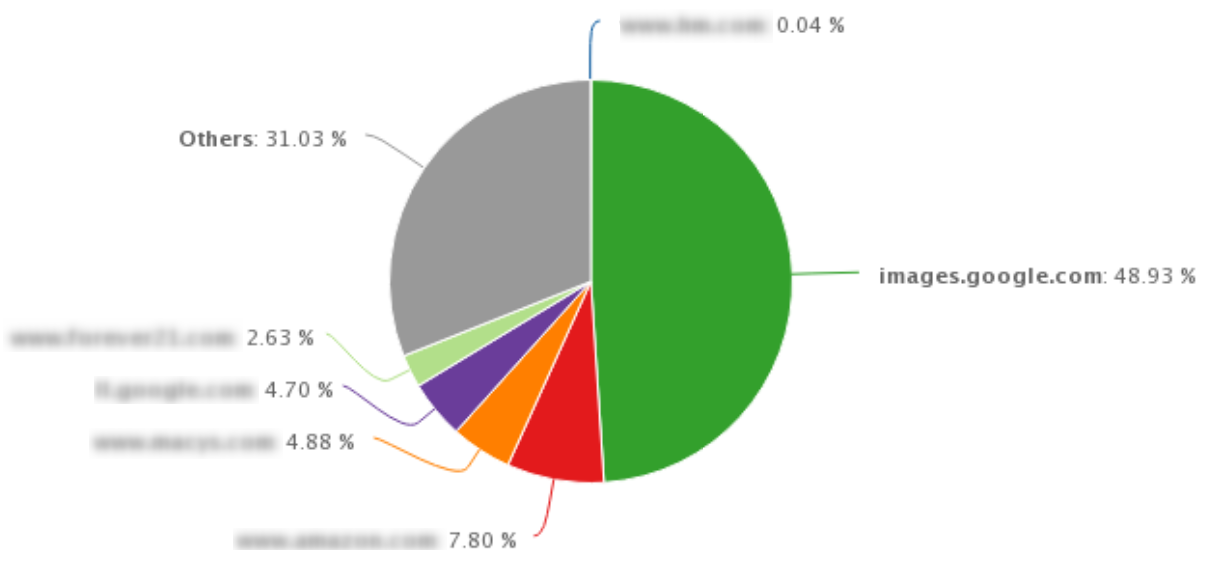
(Top Competitors Report in seoClarity.)
The Competitive Landscape
Once we have a better idea of who the true competition is, it’s time to get a sense for the full competitive landscape.
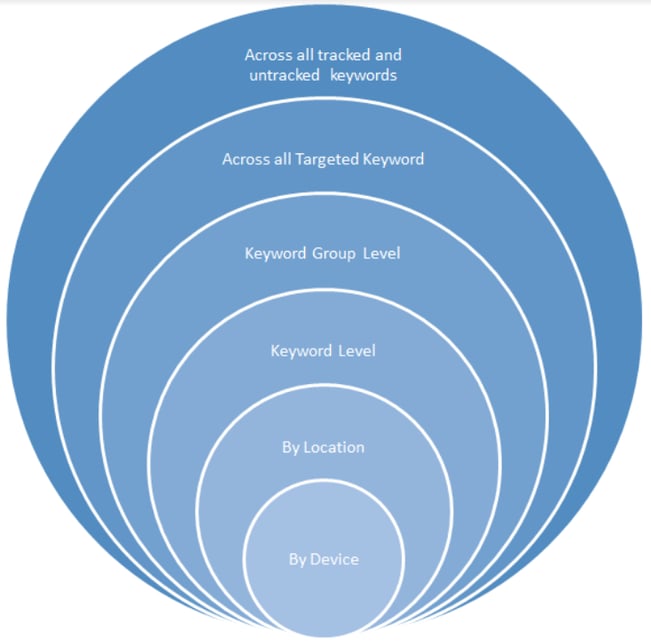
This is where an SEO platform comes in. seoClarity, for example, helps you understand your true competitors at every level of competition …
Across All Tracked and Untracked Keywords. To understand your true competitors, you need access to the broader search landscape. Consider an SEO platform that has a large keyword research data set so you can see a large universe of various keywords and topics. We’re proud to now offer the largest keyword data set, currently at 30+ billion keywords and counting! We can show any client their true competitors across this data set.
Across All Targeted Keywords. For brands who are tracking, say 10,000 keywords in the platform, your SEO platform should be able to show all of the competitors for those 10,000 terms with the click of a button.
Keyword Group Level. Tracking a group of keywords is especially important for the use case of product lines above. View at this level for metrics of an entire group or “tag” of keywords.
Keyword Level. Even more granular, dive into the competition of a specific keyword. In seoClarity, you can do this whether the keywords are tracked or not.
By Location & By Device. Additionally, it’s beneficial to dial down to the location and device type of their competitors, allowing extremely specific details to be shown about your competition. If a client wants to know all of the keywords related to their top organic search term in a specific location across mobile devices, for example, seoClarity is able to show this granular detail in a matter of seconds.
To follow along with our workflow, head over to our blog on competitor keyword analysis.
How Is the Landscape Changing Over Time?
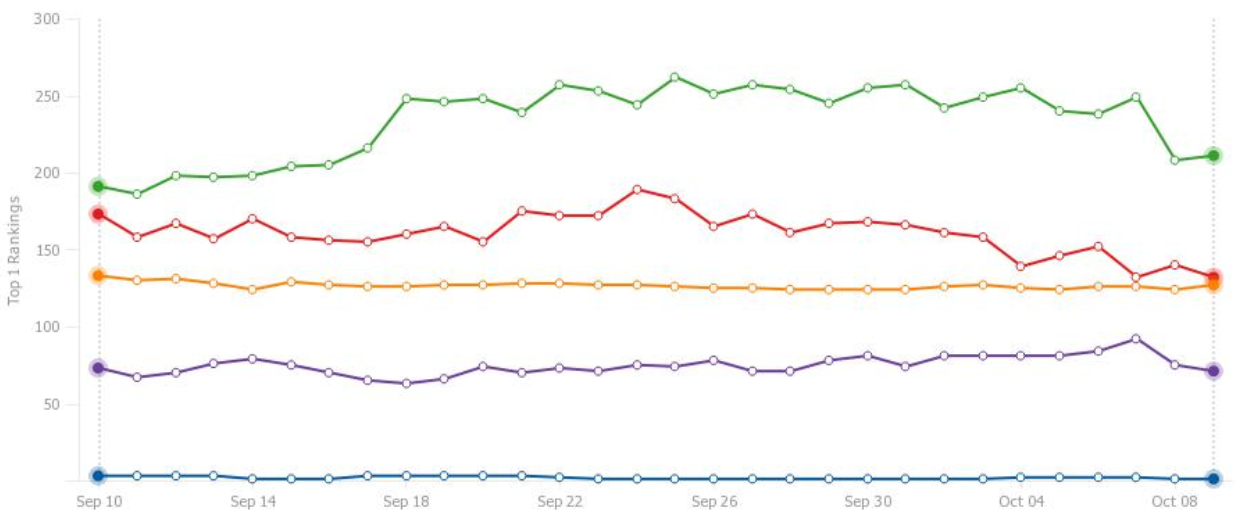
(Trended view of a brand’s competitors over the past 30 days in the Top Competitors Report.)
To fully understand your position among competitors, you need a clear picture of how the search landscape is changing over time — whether due to Google’s algorithm changes or competitors’ efforts to improve their own SEO.
This includes gains and losses in position for targeted keywords as well as those untracked keywords your competitors are ranking for.
Trended views show how this data changes over time for competitors and your own company. Keeping a pulse on these changes allows you to take advantage of new opportunities.
Identify Strengths and Gaps
After you understand who your competition is, you can identify their strengths, as well as gaps in your own understanding and application. Your SEO technology should show competitors’ top performing pages, folders and subdomains for competing domains, depending on which data set you want to handle.
Let us run an SEO analysis of your competitor's domain for you.
Analyzing this information provides insight into what your competitors know about customer search behavior that you can use in creating new content. Be sure to validate your findings with a few other companies to determine whether opportunities are worth pursuing.
- Keywords: Determine the number of top keywords a competitor is ranking for and an estimate of their generated traffic.
- Pages: Look for the pages generating the highest numbers. Then, find the keywords driving that traffic for additional opportunities.
- Folders: Gather information on how a competitor’s navigation drives traffic. This helps determine sections to add to your own website, as well as supports naming conventions for new and existing website sections. Or, use this knowledge to determine a competitor’s focus — for instance, if they added a new section that your website doesn’t have, it may give you reason to explore new possibilities.
- Subdomains: Sorting by estimated traffic can reveal a company’s strategy. If a company recently built a new sub-domain, it shows where they are investing their time and effort. For instance, tracking a blog subdomain’s estimated traffic can show if a competitor is investing in content marketing — developing new content and targeting additional informational keywords. Be on the lookout for any big drops and jumps, which can occur with an algorithm change or penalty, as well as a site transition.
How Can You Determine Content Gaps and Opportunities?
Once you have identified your true competitors, you can run a content gap analysis and identify even more opportunities. Insights gained from competitors’ data may lead you to tackle new keywords, build new pages, restructure and rename elements in your navigation, and even create additional subdomains.
Use your insights to answer the following questions:
- What are the new keyword opportunities for us to target?
- What are the new pages or sections we should build?
- Which links should we look to acquire?
- What content should we write?
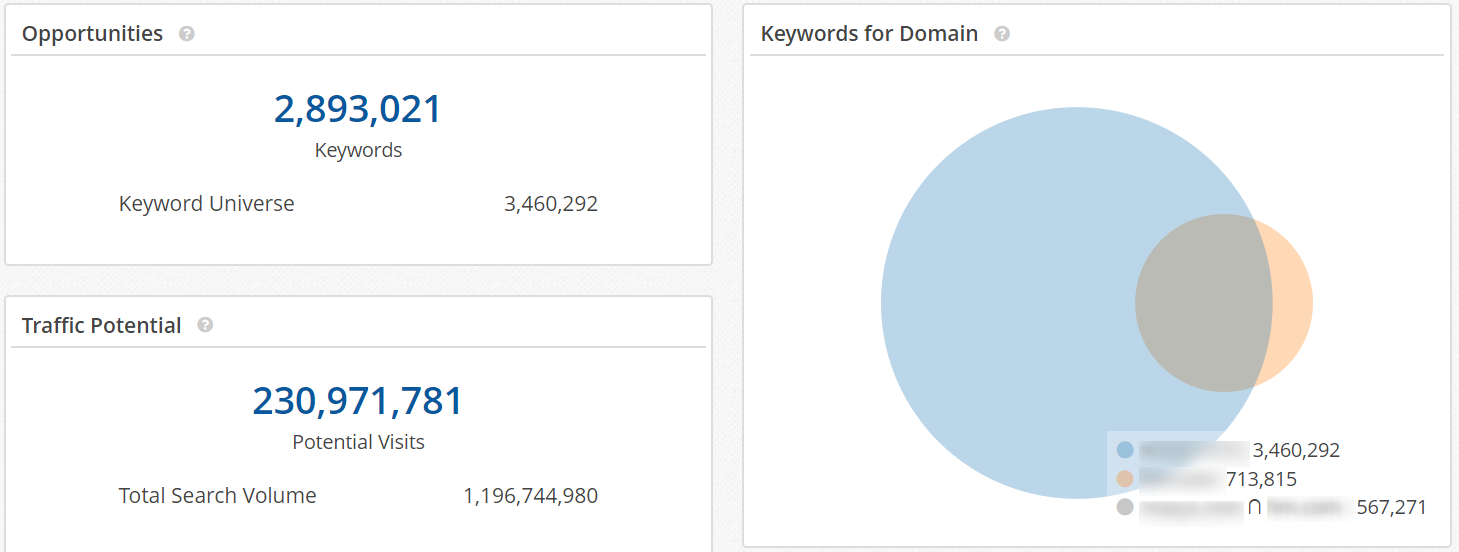
(Content Gaps display of traffic potential between a brand and it’s closest competitor.)
Tip: seoClarity’s Content Gaps feature lets users pull a list of keywords that a competitor ranks well for and compares that list to their own ranked keywords, showing overlap as well as opportunities.
Adapt and Adopt
Identifying your competitors’ top traffic-driving pages and keywords delivers insight into their strategy. Decide which information your company could take advantage of to strengthen your marketing strategy and increase rankings and traffic. Based on where your competitors are focusing, determine if it makes sense for your company to do so as well.
Then you can do the following:
- Build Pages. Understandings gained from analyzing competitors’ top traffic-driving pages may lead you to target a similar topic. Continue to leverage SEO software like an AI content writer to create authoritative pages for your targeted topics and optimize existing content assets.
- Build Links. Boost your ranking with quality internal and external links. For more information on link building, take a look at our internal links workflow, or our blog post on how to build backlinks.
- Build Folders. Evaluating a competitor’s folders and subdomains may highlight gaps and opportunities for growth. You can identify semantically-related phrases to target, long-tail keywords, and keyword patterns.
Track, Monitor, Repeat
If you execute the framework by following our competitor keyword analysis workflow, you’ll want to track your results and key metrics.
Create an SEO dashboard to track, monitor, and report on tracked keywords and the overall search landscape. Flexible dashboards provide a powerful way to monitor new trends (and the competition!) along with your KPIs and analytics data.
In seoClarity, you can define types of competitors to conveniently track the competition.
- Universal Competitors: Monitor frequently used competitors.
- Competitor Groups: Consolidate search visibility across multiple domains owned by the same competitor to see what they own in the search landscape. Additionally, create a group based on companies of your choice (for instance, big box companies or online-only retailers) to show data that is meaningful for your company.
Conclusion
The competitive framework all starts with understanding the search landscape.
Choose an SEO provider that lets you determine true competitors, identify strengths and gaps, grow your content marketing efforts, and track the results in flexible dashboards.
seoClarity provides companies with access to meaningful and comprehensive data that helps them find success in a competitive and constantly changing search landscape.





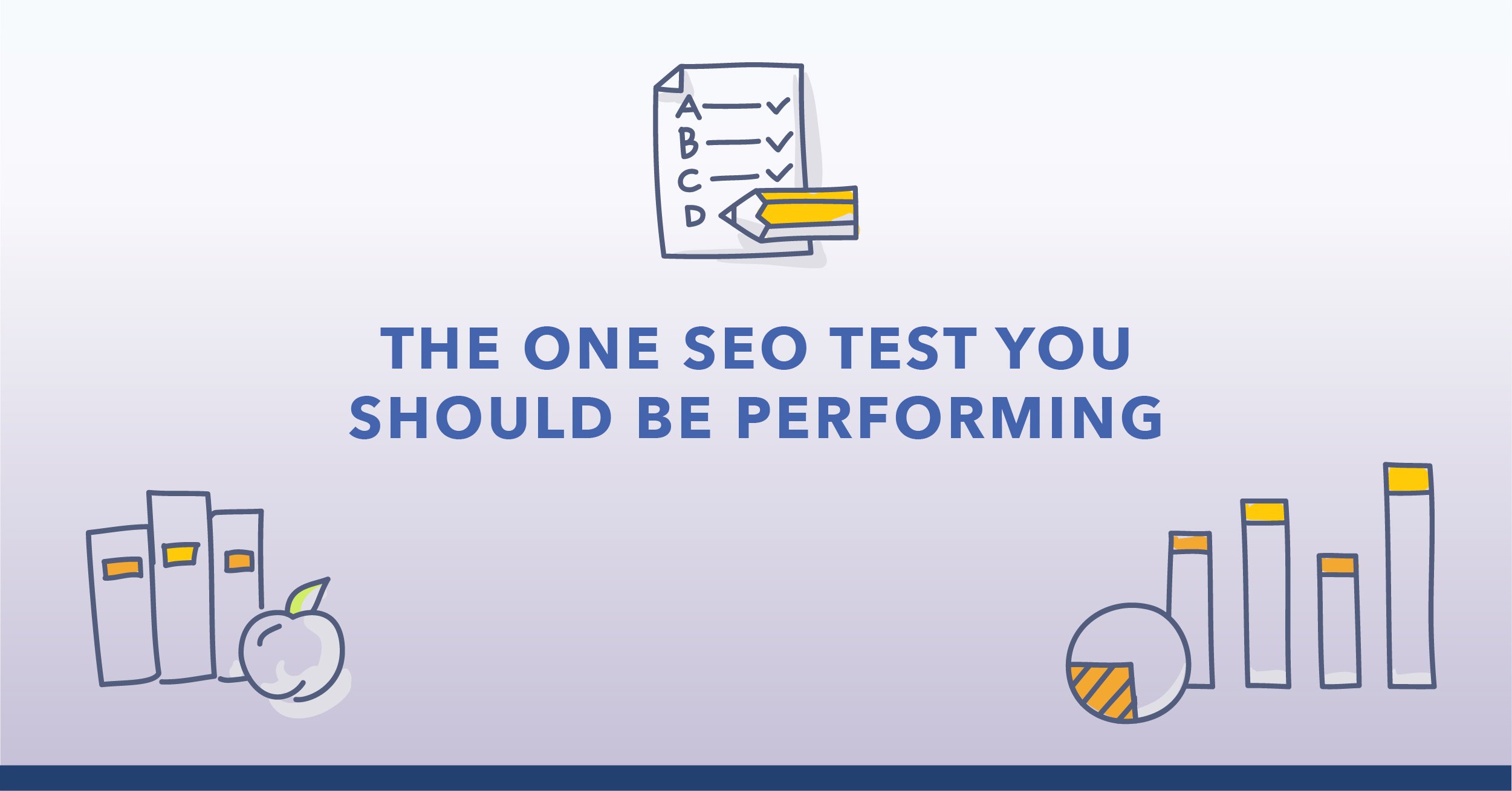

1 Comment
Click here to read/write comments